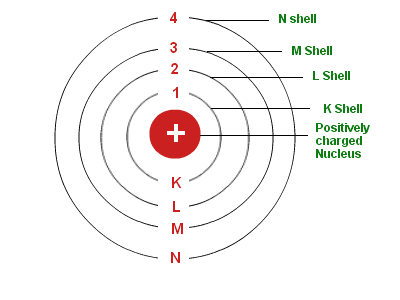Atom is composed of various sub atomic particles carrying positive or negative charge as observed and experimented by various scientists. Soon after these sub particles were discovered, scientists became eager to explain the distribution of these charged particles in an atom. It was major challenge before the scientists at the end of the 19th century to reveal the structure of the atom as well as to explain its important properties. For this different atomic models were proposed.
After Thomson’s atomic model and Rutherford’s atomic model failed to answer many questions related to the stability and energy of an atom, Neils Bohr in the year 1913 proposed an atomic structure model. He described an atom as a small, positively charged nucleus surrounded by electrons that travel in circular orbits around the positively charged nucleus with attraction provided by electrostatic forces. This can be compared with planets revolving around the sun in our solar system because of gravitational force.
Bohr’s model was basically an improved version of Rutherford’s atomic model overcoming its limitations. On most of the points, he is in agreement with him, for example the concepts of nucleus and electrons orbiting it. Bohr modified his atomic structure model by explaining that electrons move in fixed orbital’s and not anywhere in between and he also explained that each orbit has a fixed energy level. He also found that an electron located away from the nucleus has more energy, and electrons close to the nucleus have less energy.
Bohr’s Model of an Atom

Salient features of Bohr’s atomic model are:
- Electrons revolve around the nucleus in stable orbits without emitting radiant energy. Each orbit has a definite energy and is called an energy level or energy shell.
- An Energy level or orbit is designated as K, L, M, N shells. An electron is said to be in a ground state when the electron is in the lowest energy level.
- An electron absorbs or emits energy when it jumps from one energy level or orbit to another. When it jumps from a lower energy level to higher energy level it absorbs energy while it emits energy when it jumps from a higher energy level to a lower energy level.
- The difference between the energies of the two energy levels (E1, E2) is equal to the energy absorbed or emitted is determined by Plank’s equation.
ΔE = E2-E1 = hv
Where,
ΔE = energy absorbed or emitted
h= Plank’s constant
v= frequency of electromagnetic radiation emitted or absorbed
The angular momentum of an electron revolving in energy shells is given by:
mevr = nh2π
Where,
n= number of corresponding energy shell; 1, 2, 3 …..
me= mass of the electron
v= velocity
r=radius
h= Plank’s constant
Limitations of Bohr Atomic Model Theory
- Heisenberg Uncertainty Principle is violated by the model. The Bohr atomic model theory considers electrons to have both a known orbit and radius i.e. known momentum and position at the same time, which is impossible according to Heisenberg.
- The Bohr atomic model theory made correct predictions for smaller sized atoms like hydrogen, but when larger atoms are considered poor spectral predictions are obtained.
- His theory was unable to explain the splitting of spectral lines in the presence of magnetic field (Zeeman effect )
- He was also unable to explain the splitting of spectral lines in the presence of electric field (stark effect)